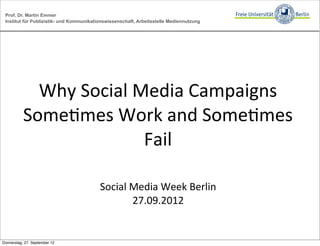Emmer smw campaigns
- 1. Prof. Dr. Martin Emmer Institut fÞr Publizistik- und Kommunikationswissenschaft, Arbeitsstelle Mediennutzung Why  Social  Media  Campaigns Some4mes  Work  and  Some4mes  Fail Social  Media  Week  Berlin 27.09.2012 Donnerstag, 27. September 12
- 2. Program How  can  the  ïŽndings  from  social  science  contribute  to  the  art  of  campainging  (for  social,  politcal,  civil  goals)? âĒ Social  Science âĒ Social  Media âĒ Campaigning  -Ââ  Strategic  Communica4on Donnerstag, 27. September 12
- 3. I. Some introductory remarks on what social science tells us about human communication (... and which might be relevant for social media) Donnerstag, 27. September 12
- 4. Basic ïŽndings: Messages trying to motivate people to go voting are more effective when forwarded by people we know and trust Donnerstag, 27. September 12
- 5. Lazarsfeld,  Paul  F./Berelson,  Bernhard/ (Paul F. Lazarsfeld) Gaudet,  Hazel  (1944):  The  People's  Choice.  How  the  Voter  Makes  Up  His  Mind  in  a  Presiden4al  Campaign.  New  York:  Duell,  Sloan  and  Pearce. (c) Bardwell Press Donnerstag, 27. September 12
- 6. EïŽects  of  mediated  campaign  communica4on: âĒ  Ac4va4on âĒ  Reinforcement âĒ  âTwo-Ââstep-ÂâïŽowâ  of  communica4on but:  almost  no  persuasion  Donnerstag, 27. September 12
- 7. Kahneman,  Daniel  (2011):  Thinking,  Fast  and  Slow.  New  York:  Farrar,  Straus  and  Giroux. Pedy,  Richard  E./Cacioppo,  John  T.  (1986):  Communica4on  and  Persuasion:  Central  and  Peripheral  Routes  to  Ahtude  Change.  New  York:  Springer. Donnerstag, 27. September 12
- 8. Two  ways  of  processing  informa4on and  making  up  oneâs  mind: issue requiring  decision peripheral  path (fast) central  path resources (slow) (4me,  thought  etc.) ephemeral  decision stable  decision (e.g.  opinion) (e.g.  opinion) Donnerstag, 27. September 12
- 9. Conclusion  I: Social  Mediaâs  advantages  for  campaigning: ...  they  give  access  to  personal  networks  of  people  and  their  credibility ...  opportuni4es  both  for  peripheral  &  central  paths  of  opinion  building Donnerstag, 27. September 12
- 10. Conclusion  I  b: The  individual  is  no  longer  just  part  of  a  âtarget  groupâ  but  a  relevant  player Donnerstag, 27. September 12
- 11. Example The  target-Ââgroup  vs.  player  problem: http://www.shakesville.com/2012/09/mitt-romney-releases-tax-return.html Donnerstag, 27. September 12
- 12. II. Needs,  expecta4ons,  mo4ves  of  individuals  as  key  to  campaign  par4cipa4on Donnerstag, 27. September 12
- 13. Why  do  people  communicate?  âĒ  Ra4onal  reasons/individual  beneïŽt âĒ  Social  needs:  surveillance,  integra4on,  iden4ty  building âĒ  Emo4onal  reasons:  relaxa4on,  entertainment,  fun âĒ  Habitualiza4on,  rituals ...  and  why  not? âĒ  Relevance âĒ  Costs:  money,  4me,  knowledge âĒ  Emo4ons:  fear  of  isola4on,  ... Donnerstag, 27. September 12
- 14. Example Mo4va4ons  of  German  state  MPs  for  being  present  online  (2007) Be Transparent 93 Comm. to Constituency 88 Positive Self-Presentation 82 Attract Young Voters 77 Agenda Setting 77 Support for Positions 75 Win Voters 72 Raise Voting Participation 70 Get Feedback 69 Win Campaigners 63 Media Relations 56 Sharpen Profile 48 0% 20% 40% 60% 80% 100% Donnerstag, 27. September 12
- 15. III. Examples: Â ACTA Donnerstag, 27. September 12
- 16. °äēđģūąčēđūąēĩēÔ-ÂâHģÜēú: focused  on  resources,  how-Ââtoâs,  connec4ng  people Donnerstag, 27. September 12
- 17. Combina4on  of: âĒ  Variety  of  modes  of  communica4on âĒ  Informa4on  &  entertainment âĒ   Variety  of  perspec4ves  and  arguments Donnerstag, 27. September 12
- 18. Go  oïŽine  (too) http://www.ïŽickr.com/photos/digitalegesellschaft/7354521426/ Donnerstag, 27. September 12
- 19. Itâs  not  all  digital  and  social: âĒ  âeconomy  of  aden4onâ  -Ââ  news  factors âĒ  âIssueâ-Ââissues:  rejec4ve/protest  vs.    projec4ve/forma4ve âĒ  context  (framing)  and  environment   (issue-Ââcompe44on) Donnerstag, 27. September 12
- 20. IV. Risks  &  Problems Donnerstag, 27. September 12
- 21. Being  âunsocialâ: âĒ  Trying  to  run  a  campaign  on  your  own   (companies,  lobby-Ââgroups) âĒ  may  spur  opposi4on:   feeling  of  being  abused,  intransparency âĒ  strategy  to  keep  control  of  messages Donnerstag, 27. September 12
- 22. Key  risks: âĒ  Losing  control âĒ  Not  knowing  what  your  goals  are     (likes  or  votes?) âĒ  Misuse  of  channels  (SWOT) Donnerstag, 27. September 12
- 23. V. Conclusions  &  Discussion Donnerstag, 27. September 12
- 24. âĒ  Think  about  the  needs  of  you  supporters âĒ  Integrate  their  skills,  knowledge,    mo4va4on,  contacts  into  your  campaign âĒ  Take  them  to  ac4on âĒ  Be  transparent  and  authen4c Donnerstag, 27. September 12
- 25. ģūēđ°ų4ēÔ.ąðģūģūąð°ų°ŠīÚģÜ-Ââbąð°ųąôūąēÔ.ŧåąð @mjemmer hdp://www.mar4n-Ââemmer.net Donnerstag, 27. September 12

























